Art & Exhibitions
Inside the Mistake Room, Los Angeles’s Newest Art Space
Cesar Garcia, founding director of the Mistake Room, aims to compensate for LA institutions' local focus.
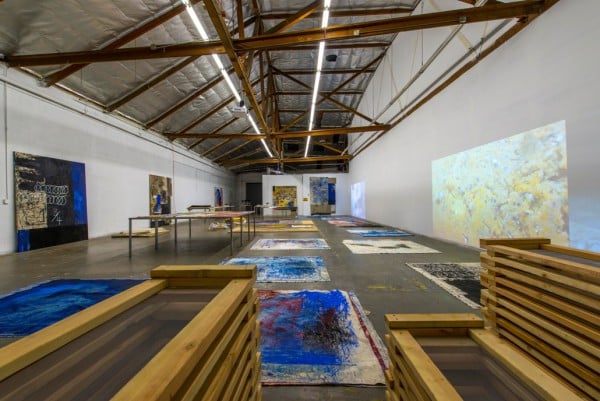
Cesar Garcia, founding director of the Mistake Room, aims to compensate for LA institutions' local focus.

Benjamin Sutton

Amid the arrival of Philippe Vergne as the Museum of Contemporary Art’s new director, LACMA’s upcoming expansion, the Hammer Museum’s second biennial, and the impending return of Paul Schimmel, there’s been another major change in Los Angeles’s contemporary art field. The city’s newest non-profit art space, the Mistake Room, inaugurated its raw warehouse building downtown in January with a show by red-hot London-based Colombian artist Oscar Murillo. In the space’s tone-setting first show, The Distribution Center, the young sensation engages specifically with the site’s past function as a manufacturing facility.
“He’s been part of the entire process of building the space, so it’s really been a coming of age story for both him as an artist and for us as an institution,” says the Mistake Room’s founding director and chief curator Cesar Garcia. “We were very fortunate that things with his career have been great the past couple of years. But he’s been super supportive of the space. He just joined our board as an artist trustee.”
After Murillo’s show, the warehouse will be renovated by architect Alfonso Medina of T38 Studio, with the revamped building slated to be complete at the end of the summer of 2014—though it will continue to host events throughout the construction. For Garcia, the Mistake Room fills an important gap in the Los Angeles art scene as a mid-sized space presenting works and projects by internationally renowned artists who have never shown in Southern California.
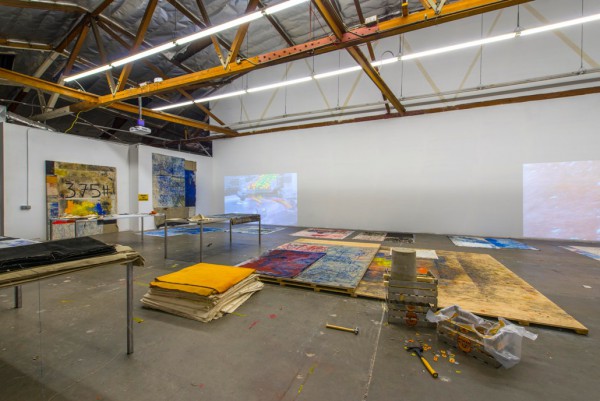
Oscar Murillo: Distribution Center. Installation View at The Mistake Room, Los Angeles, CA.
Photo: Courtesy of Josh White/JW Pictures.
“In terms of institutions, LA has had really small nonprofits, or big museums, but it’s never had a middle,” Garcia says. “And by that I mean Artists Space or Sculpture Center in New York; in Chicago you have the Renaissance Society. They’re midsize spaces that do substantial shows that end up travelling, and collaborate with regional museums. And thinking about how that could make sense in a way here in LA. Could that be sustainable?”
In addition to that shortage of dynamic, mid-sized spaces for contemporary art, Garcia was increasingly apprehensive about Los Angeles art institutions’ inward focus. While support from hometown museums has long been a hallmark of the city’s art community, he was concerned that LA was shutting itself from the international art community. That fear became especially acute when, in 2012—while he was the senior curator at LAXART—Garcia was appointed U.S. commissioner at the 2012 Cairo Biennale and began to travel throughout the Middle East.
“It was really interesting to be in all of these places, where there was such a dynamism happening among the young community of artists—and how things were changing—and it really felt palpable,” he recalls. “Coming home, I felt very disconnected—meaning that LA started to feel a little bit irrelevant. Irrelevant with what was happening around the world. You started to see museums like MoMA and the Tate that were launching major initiatives to increase their acquisitions of non-western art, or refocusing their acquisitions priorities and doing more projects international in scope. And LA felt so far away from that.”
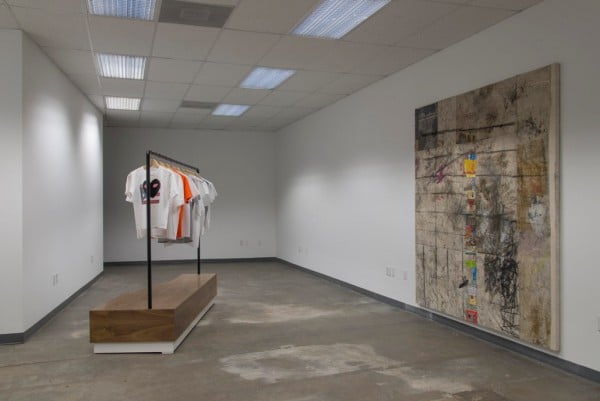
Oscar Murillo: Distribution Center. Installation View at The Mistake Room, Los Angeles, CA.
Photo: Courtesy of Josh White/JW Pictures.
In response to that perceived insularity, Garcia and Mistake Room senior curator Kris Kuramitsu have devised their first three-year curatorial cycle to be focused on artists from outside the historically dominant art world axis of North America and Western Europe. The next show in this cycle, following Murillo’s project and the building renovation, will be a solo exhibition by New York-based Thai artist Korakrit Arunanondchai. That will be followed by a major group show in the fall of 2014.
“It’s sort of going to be an introduction to a group of artists who are working outside the United States and Western Europe, and it will be an opportunity to introduce the set of ideas that we’re going to be very focused on during the first two or three years of our program,” Garcia explains. “We’re going to focus on the ‘Global South,’ not just in geography, but thinking about it as a condition of living, thinking about it in terms of economics, understanding the social position and political perspective.”
For Garcia, this type of broader international programming in LA has become even rarer in the last four to five years due to the turmoil at MOCA.
“They were the ones that when Ann Goldstein was here had more of a connection to institutions abroad, and Paul Schimmel would do thematic shows that were international in scope, and you had the Murakami show, and you had shows like WACK! [Art and the Feminist Revolution] that Connie Butler did there,” he recalls. “They were shows that were global in scope, and they had global connections, but ever since it’s been so tumultuous, it has left a gap in terms of programming for an institution that could do more internationally focused work.”
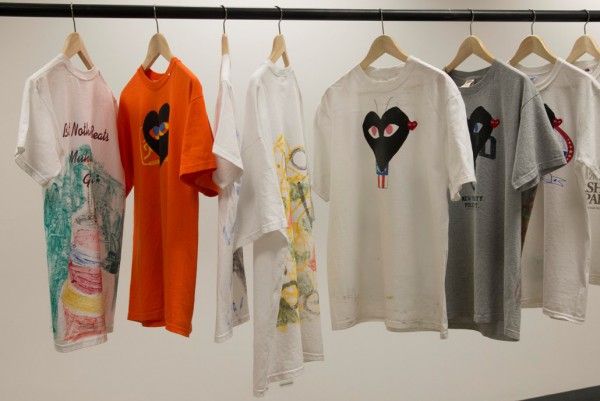
Oscar Murillo: Distribution Center. Installation View at The Mistake Room, Los Angeles, CA.
Photo: Courtesy of Josh White/JW Pictures.
In a way, then, the Mistake Room will provide a much-needed venue for exhibitions with a more global outlook in a city whose institutions have become very inwardly focused, as evidenced by major initiatives like the Getty’s Pacific Standard Time and the Hammer Museum’s Made in L.A. biennial. Garcia’s next major curatorial effort will be a multi-show exhibition engaging with identity politics.
“It could be three or four shows that will happen over this span of the next three years and it’s called Histories of a Vanishing Present,” he explains. “it’s a show that’s going to look at identity politics, but it’s going to look at identity politics in a particular generation of artists who are born after 1980, who don’t necessarily have direct links or relationships anymore to their mother countries or to their places of heritage, because they’re second or third generation, and yet at the same time they’re always battling with ideas of history and identity as burdensome in a way.”
“Oscar Murillo: Distribution Center” continues at the Mistake Room through April 12.
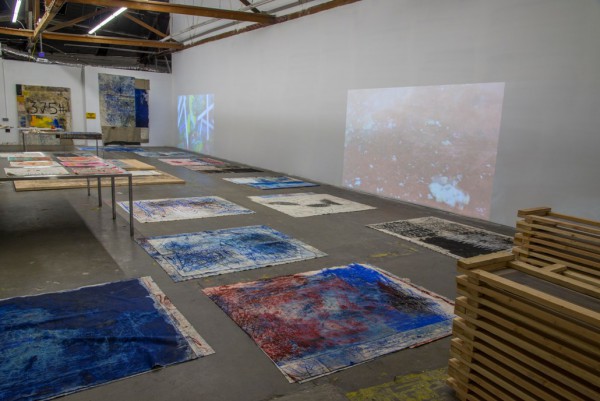
Oscar Murillo: Distribution Center. Installation View at The Mistake Room, Los Angeles, CA.
Photo: Courtesy of Josh White/JW Pictures.
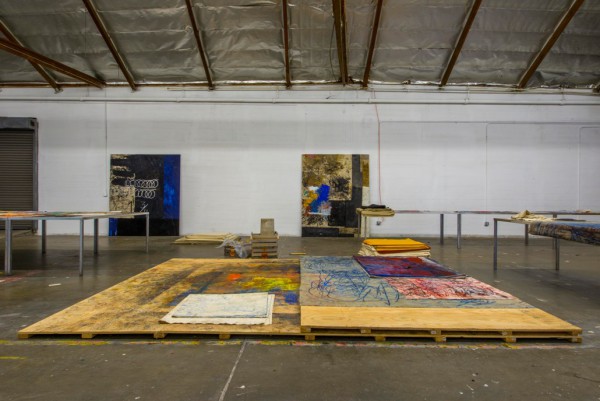
Oscar Murillo: Distribution Center. Installation View at The Mistake Room, Los Angeles, CA.
Photo: Courtesy of Josh White/JW Pictures.
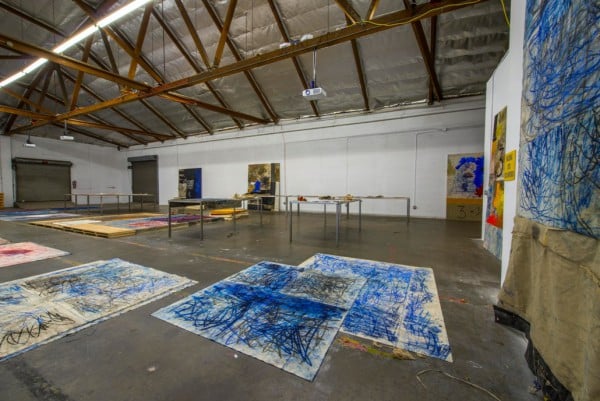
Oscar Murillo: Distribution Center. Installation View at The Mistake Room, Los Angeles, CA.
Photo: Courtesy of Josh White/JW Pictures.